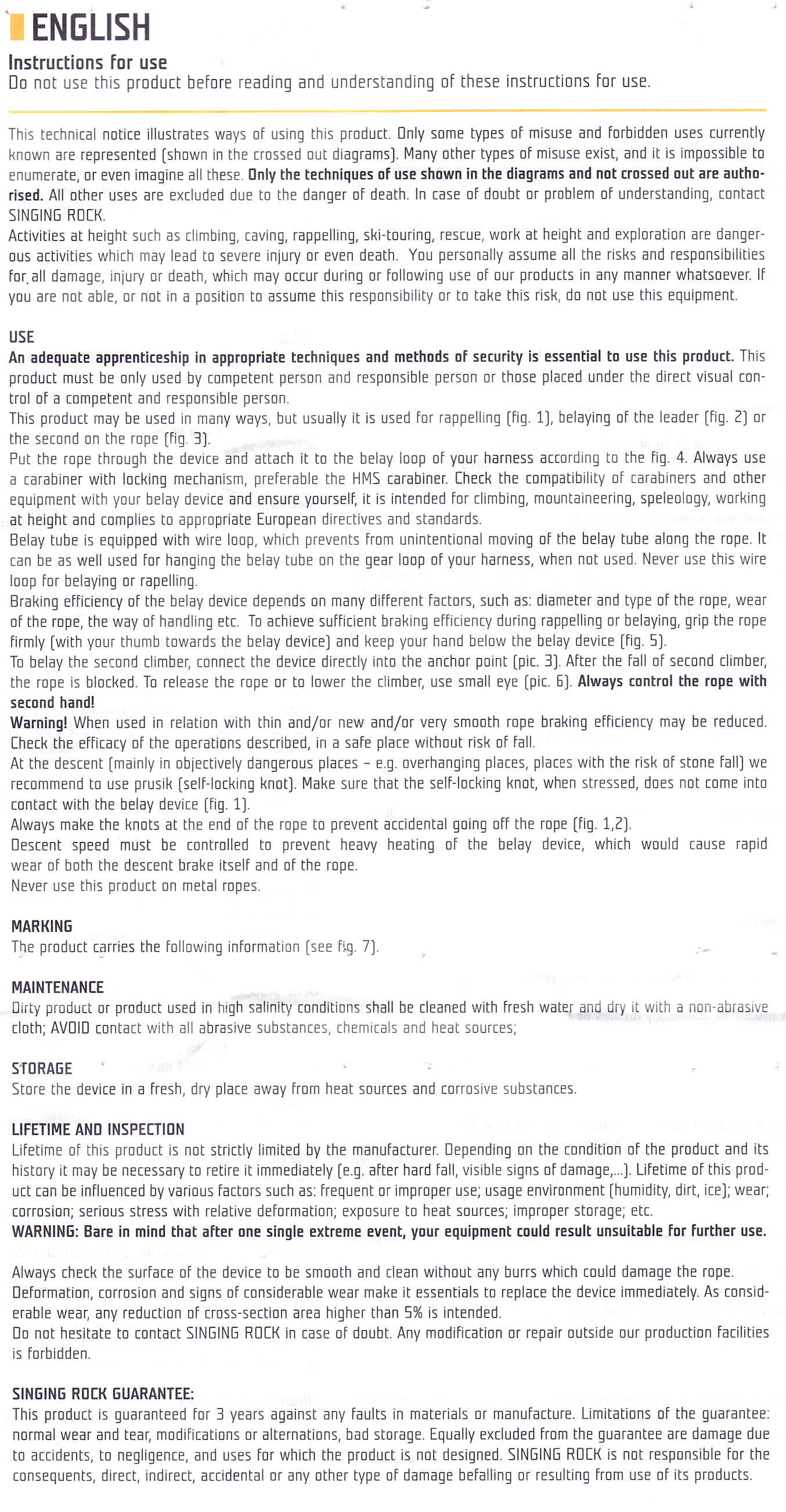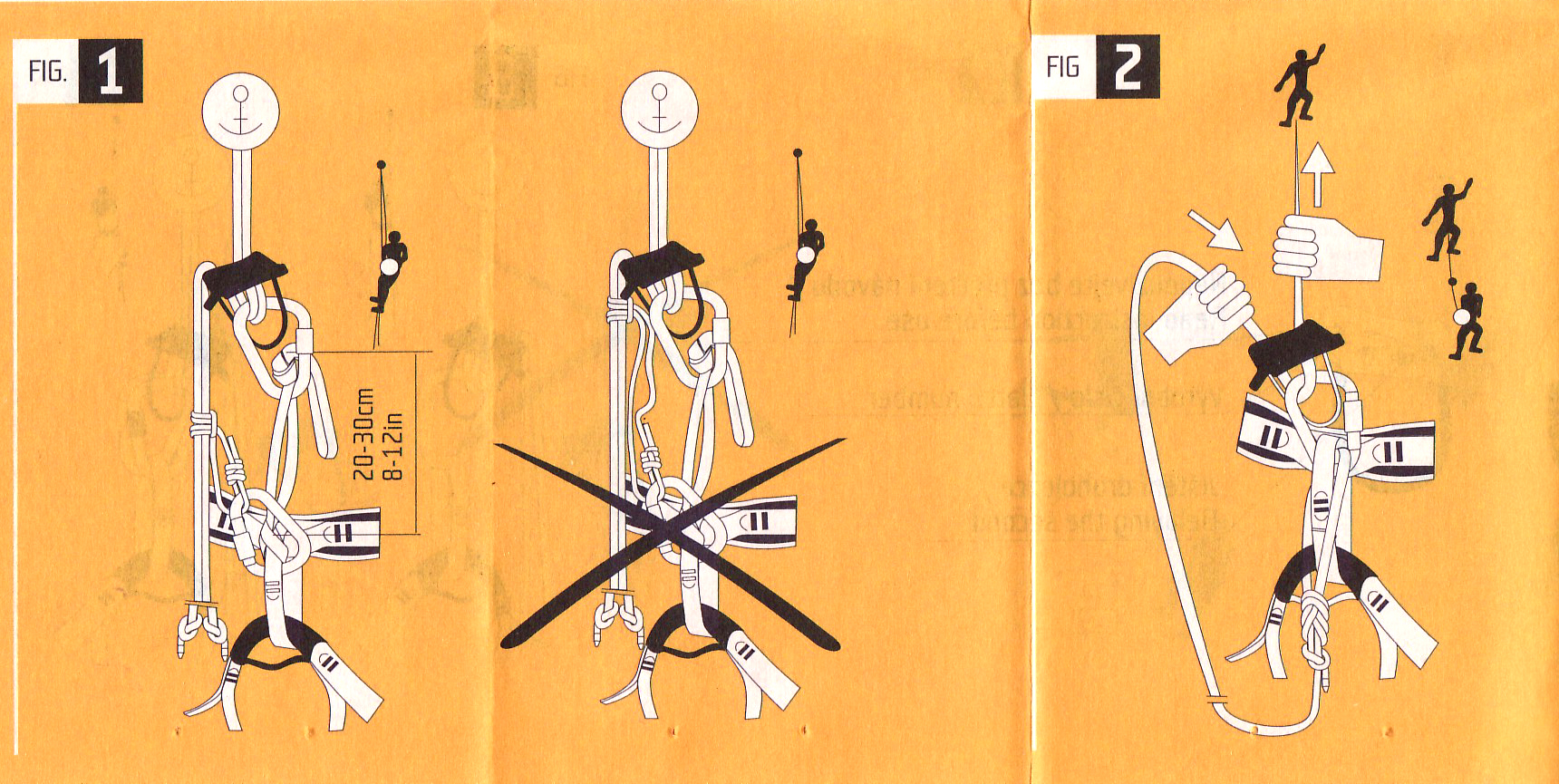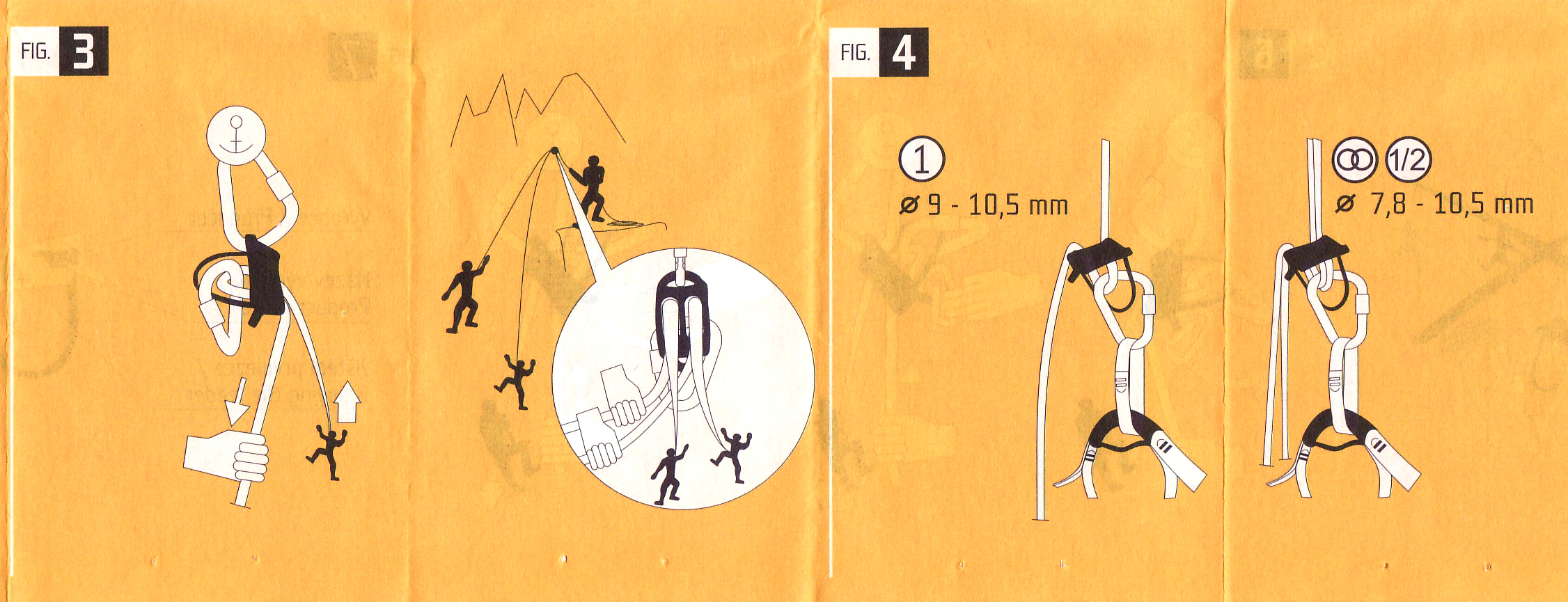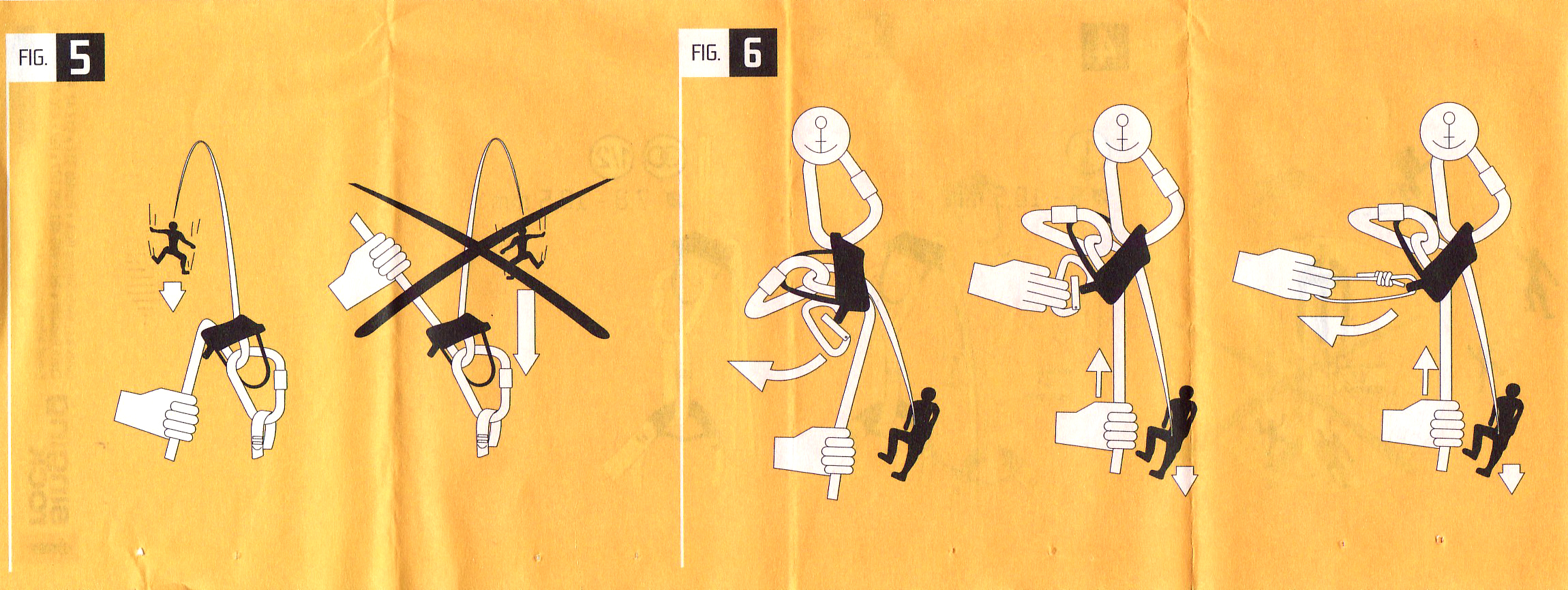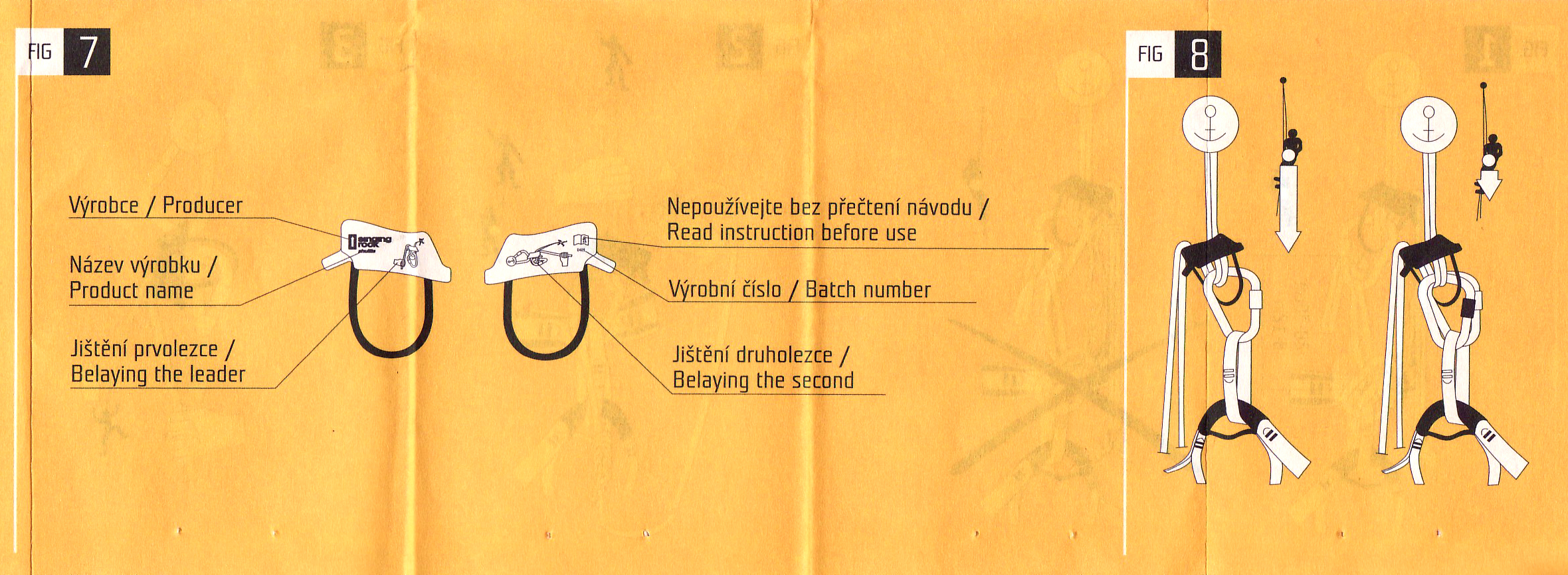Overview
[ Top
| Buddy
| Hornet
| Shuttle
| Return to Belay Tubes
]
Standard
(#1609)
Technical Details
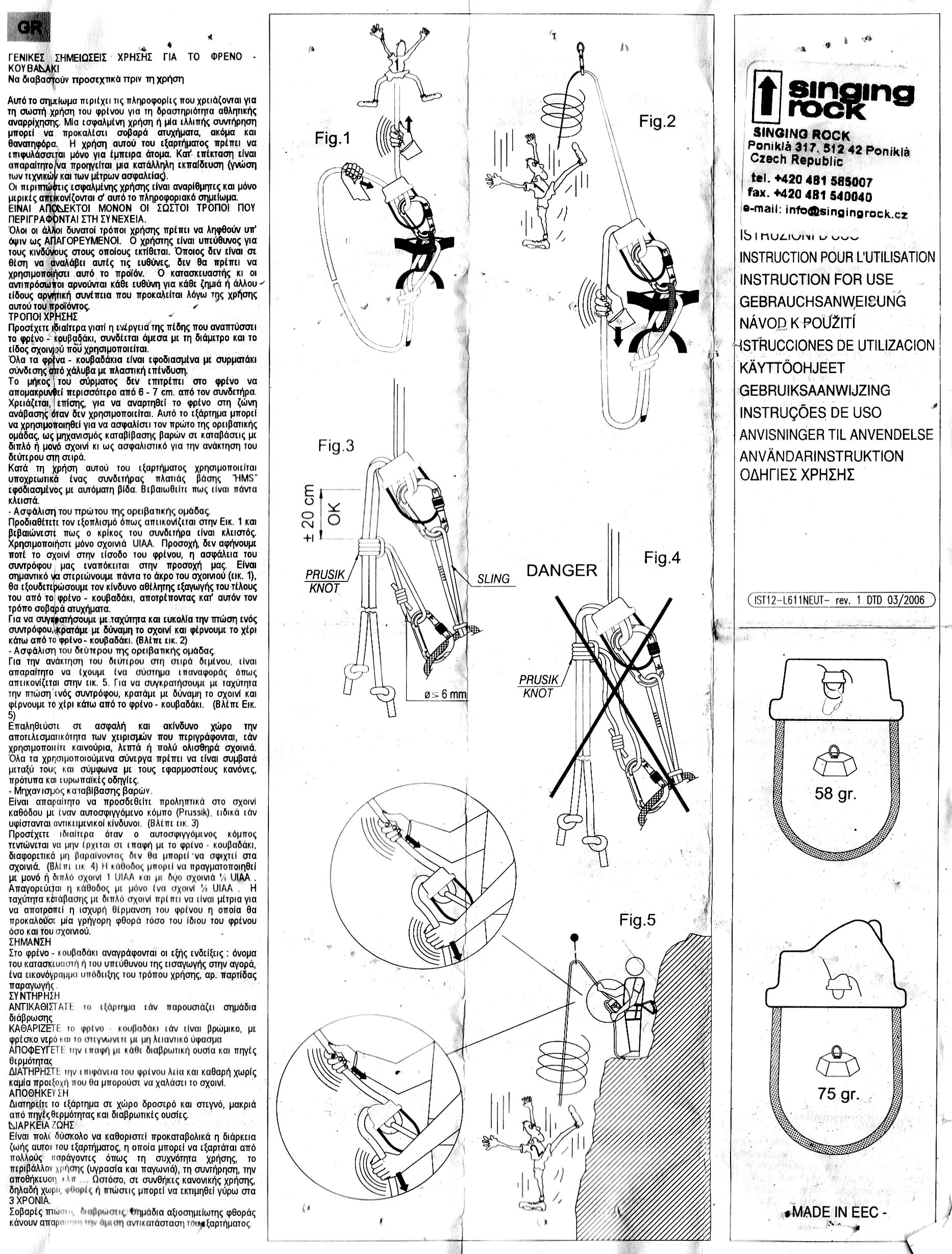 I acquired my Singing Rock on eBay
in 2008.
I acquired my Singing Rock on eBay
in 2008.
The Singing Rock belay tube is forged from aluminum alloy and
then soft anodized. Mine is 53 mm. long, 46 mm. wide,
100 mm. high, and weighs 58 g. The slots are 33 mm. long and 14 mm. wide. The top of the Omega oval carabiner
that I use for comparing belay tubes sits 15 mm. below the
ends of the slots. The keeper is a stiff plastic-covered cable.
One side of the tube is printed with arrow pointing up inside
a rectangle, "singing rock," "MADE IN EEC,"
and "0204" (presumably the date of manufacture). The
other side is printed with an illustration showing how to rig
the device.
I saw my first Singing Rock belay tube in a climbing shop in
Prague in December 2000, on one of my last days in the Czech
Republic. The salesman was busy, I was in a hurry, and I assumed
that I could easily find another one once I got home. I didn't
think that it would take nearly eight years!
The Singing Rock is one of the following closely-related belay tubes, all called "ATCs" after the original Black Diamond Air Traffic Controller:
Each of these is 54±3 mm. long, 46±1 mm. wide, and weighs 59±9 g. Their slots are all 32±1 mm. long and 14±1 mm. wide. They all have plastic-covered cable keepers.
The Black Diamond ATC was the first of these to appear, by many years. The basic design evolved and similar devices appeared from others.
The ATC is a lightweight,
popular belaying device among climbers. Rigging is simple: insert a bight of rope
and clip it with a suitably anchored carabiner, making sure that
the rope is not running over the keeper. Two-rope rigging is similar.
On thinner ropes, adding another carabiner helps.
My biggest complaint is that none of these give me enough
friction when rappelling with a heavy load on fast 9 mm.
rope. I also prefer more friction while belaying, unless my partner is particularly lightweight. For these reasons, I prefer using a Trango Jaws or one of its equivalents.
Any of these will overheat badly on long rappels. Overheating is not an issue when belaying, but can be a concern when lowering someone more than a short distance.
There are four different shell styles in use::
- There is a small shelf at each end of the shell with a hole passing through it. The keeper cable has a crimp at the ends, which are visible from the top of the device.
- There is a small shelf at each end of the shell with a blind hole in the bottom. The keeper cable enters the holes, and is staked in place. The stake dimples are visible at the ends of the device.
- There is a bulge at each end of the shell with a blind hole in the bottom. The keeper cable enters the holes, and is staked in place. The stake dimples are visible at the ends of the device.
- Like style III, but the shell has a shallow valley above the bulge.
The differences between the styles are cosmetic rather than functional.
None of the keepers-to-shell are strong enough to support body weight, so don't be stupid enough to rely on a keeper to protect you.
There are also several different diameter keeper cables used on these. Cable keepers are a compromise between a
cord that stows easily but tends to get tangled in use, and a
rigid rod that stands up to the rope running over it (by accident,
of course). I prefer a stiff keeper, but any of these are stiff enough to be used without significant problems.
[ Top
| Standard
| Hornet
| Shuttle
| Return to Belay Tubes
]
Buddy
(#1744)
Technical Details
I acquired my Singing Rock Buddy from Above the Ridge in 2012.
The Singing Rock Buddy is a plain belay tube. Mine is 56 mm. long, 44 mm. wide, 74 mm. high, and weighs 54 g. It is forged from aluminum ally and then soft anodized. It has two slots and a plastic-covered cable keeper. The slots are 33 mm. long and 15 mm. wide. The top of the Omega oval carabiner that I use for comparing belay tubes sits 13 mm. below the ends of the slots.
One side is printed with the Singing Rock logo (an up-pointing arrow), "Singing Rock," and "0410."
The Buddy is another ATC-type
belay tube with a moderately stiff cable keeper.
[ Top
| Standard
| Buddy
| Shuttle
| Return to Belay Tubes
]


 Hornet
Hornet
(#841)
Technical Details
 I bought my Singing Rock Hornet new on eBay in 2006.
I bought my Singing Rock Hornet new on eBay in 2006.
The Hornet is a notched belay tube. It is forged from aluminum
alloy and then hard anodized. Mine is 60 mm. long,
47 mm. wide, 111 mm. high, and weighs 73 g.
The slots are 33 mm. long and 15 mm. wide.
The top of the Omega oval carabiner that I use for comparing belay
tubes sits 9 mm. below the ends of the slots. The keeper
is a stiff plastic-covered cable.
One side of the Hornet is printed with an illustration showing
how to rig the device, and arrow pointing up inside a rectangle,
"singing rock," "MADE IN EEC," and "0205"
(presumably the date of manufacture).
I like this design enough to give it three stars:



The following notched belay tubes, including the Singing Rock Hornet, are essentially the same device:
Each of these is 60±1 mm. long and 48±1 mm. wide, and has a weight in the 76±3 g. range. Their slots are all 33 mm. long and 15 mm. wide.
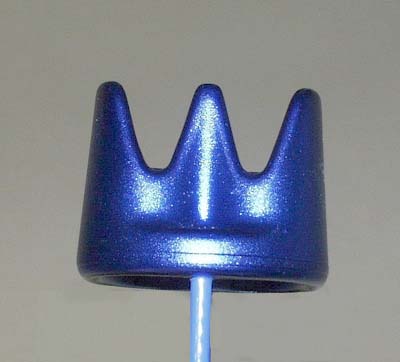 These are just like many other devices except for one little difference,
but that difference makes any of these a much better device than those others. The special feature is the teeth. First of all, if
you don't need them, turn the device 180 degrees and they are
out of the way. On the other hand, if you want more friction,
then these teeth canprovide it. This is the only device design of this size and
weight that I feel comfortable rappelling my 9 mm. haul line
on. With any others, I never really felt completely in control
(to be fair, I haven't tried this on the the Omega
Pacific SBG or the Simond Cubik).
The extra control is well worth carrying the extra 15 or 20 grams. One
caution: like all belay tubes and tubers, these can get very hot on rappels.
These are just like many other devices except for one little difference,
but that difference makes any of these a much better device than those others. The special feature is the teeth. First of all, if
you don't need them, turn the device 180 degrees and they are
out of the way. On the other hand, if you want more friction,
then these teeth canprovide it. This is the only device design of this size and
weight that I feel comfortable rappelling my 9 mm. haul line
on. With any others, I never really felt completely in control
(to be fair, I haven't tried this on the the Omega
Pacific SBG or the Simond Cubik).
The extra control is well worth carrying the extra 15 or 20 grams. One
caution: like all belay tubes and tubers, these can get very hot on rappels.
I borrowed the following paragraphs from Trango's web site, although they should apply to any of the devices in the table:
Jaws stops better than most belay/rappel devices. The
addition of the V notches really grabs the rope, assisting in
slowing down the fall. In lab tests using a UIAA drop tower,
an 11 mm. rope, an 80-kg weight with a fall factor of 1.2,
and a clutch holding the rope with a 50-lbf slip threshold, we
found the following results:
| Pyramid/ATC/Tuber style devices |
16" - 20" slip, no rope damage |
| GriGri |
1" - 3" slip, no rope damage |
| Jaws |
6" - 8" slip, no rope damage |
Jaws allows you to adjust the rope friction during a
rappel. By flipping the rope out of the notches and over the
side plates at the start of a long rappel, you can reduce the
friction the device gives you at the start. When the rappel begins
to speed up as you get closer to the ground, flip the ropes back
into the notches to slow it down.
You must rig Jaws correctly. It's not symmetrical so
you need to be sure the notches are on the brake hand side of
the rope, not on the side which goes to the leader. Also, because
of the additional friction provided by the device you'll find
that the beginnings of long rappels can be a bit jerky. The solution
is to allow rope to slide through by varying the angle of your
brake hand rather than just letting rope slip through. On low
angle slab rappels, turn Jaws around so the notches are on the
anchor side and your brake hand is on the smooth side.
[ Top
| Standard
| Buddy
| Hornet
| Return to Belay Tubes
]
Shuttle
(#1713)
Technical Details
I acquired my Singing Rock Shuttle from Outfitter’s Outlet in 2011.
The Singing Rock Shuttle is a notched belay tube. It is forged from aluminum alloy and then soft anodized. Mine is 74 mm. long, 39 mm. wide, 83 mm. high, and weighs 63 g. The slots are 34 mm. long and 14 mm. wide. The top of the Omega oval carabiner that I use for comparing belay tubes sits 20 mm. below the ends of the slots. The plastic-covered cable keeper is moderately flexible.
One side is printed with an up-pointing arrows in a box, "singing rock," "shuttle," and a rigging illustration. The other side is printed with a different rigging illustration that shows the guide mode, a book-with-an-"i" icon, and "0510."
The shuttle is more compact than most other guide-type belay tubes. The keeper is angled with respect to the slots, a feature that seems to have no advantage or disadvantage. The central rib is relieved on the bottom to facilitate getting a carabiner into the carabiner eye.
[ Top
| Standard
| Buddy
| Hornet
| Shuttle
]




